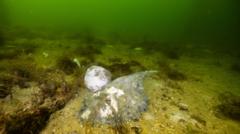In South Australia, a toxic algal bloom has transformed the once-clear waters into a disturbing green, leading to the deaths of over 400 marine species. State Premier Peter Malinauskas has called this crisis a "natural disaster," but the federal government has not officially recognized it as such, despite the dire situation.
The bloom has been expanding since March, now covering an area twice the size of Australia’s capital territory. Although authorities attribute this incident to natural phenomena exacerbated by climate change—such as ocean warming and nutrient pollution—the federal government has only offered A$14 million (around $9 million) in support, without triggering a formal disaster response protocol.
Malinauskas has pledged to match the federal funding to assist with research, clean up efforts, and local industry support. Criticism has emerged from local leaders, including Greens Senator Sarah Hanson-Young, who believes that if this crisis affected a more affluent area like Bondi Beach, the response would be swifter.
Federal Environment Minister Murray Watt acknowledged the alarming effects of the bloom but maintains that it does not fit the legal criteria for a natural disaster. The bloom, widening from Coorong to the Yorke Peninsula, is not just an ecological catastrophe; it is also severely impacting local fishermen, some of whom have faced months without income. "I've got fishermen in tears on the phone," said Ian Mitchell, who connects fishers to the market. This situation underscores the urgent need for effective responses to environmental crises.
The bloom has been expanding since March, now covering an area twice the size of Australia’s capital territory. Although authorities attribute this incident to natural phenomena exacerbated by climate change—such as ocean warming and nutrient pollution—the federal government has only offered A$14 million (around $9 million) in support, without triggering a formal disaster response protocol.
Malinauskas has pledged to match the federal funding to assist with research, clean up efforts, and local industry support. Criticism has emerged from local leaders, including Greens Senator Sarah Hanson-Young, who believes that if this crisis affected a more affluent area like Bondi Beach, the response would be swifter.
Federal Environment Minister Murray Watt acknowledged the alarming effects of the bloom but maintains that it does not fit the legal criteria for a natural disaster. The bloom, widening from Coorong to the Yorke Peninsula, is not just an ecological catastrophe; it is also severely impacting local fishermen, some of whom have faced months without income. "I've got fishermen in tears on the phone," said Ian Mitchell, who connects fishers to the market. This situation underscores the urgent need for effective responses to environmental crises.






















